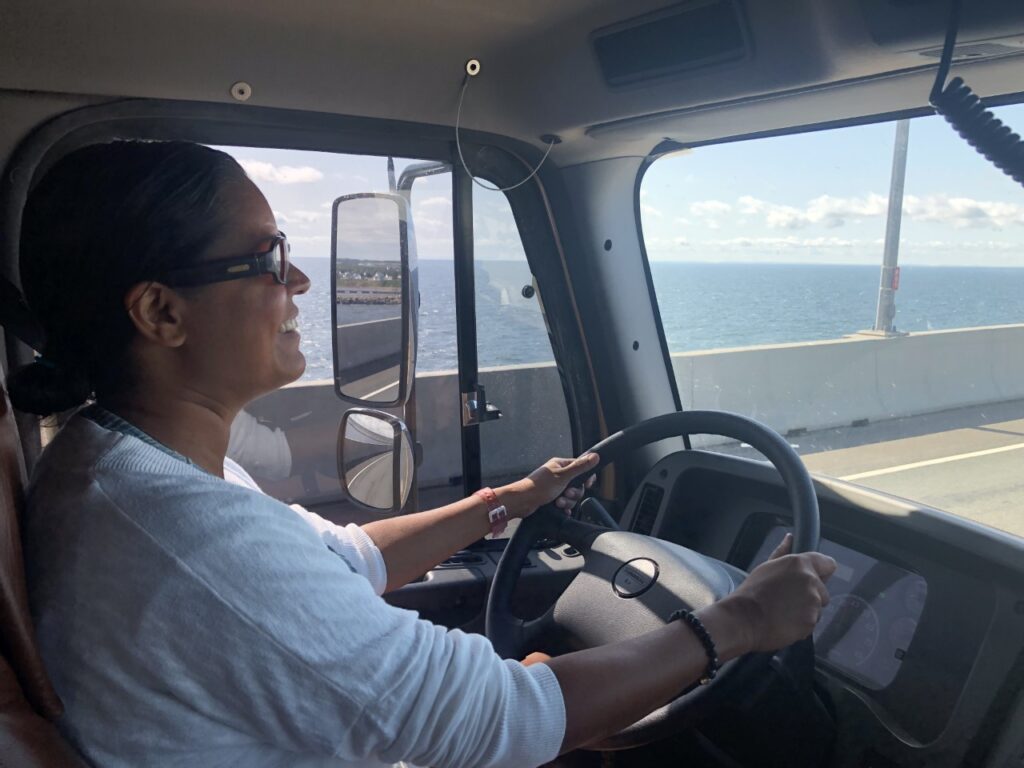
The last thing I expected to do was find myself in a classroom learning how to operate a vehicle with air brakes. I work as an IT project manager in office settings. But for fun, our family loves to go camping. Our RV has air brakes requiring a special designation on your license in Ontario. I wanted to learn to drive it safely (and legally). Although I was a passenger 99% of the time, I wanted to be able to give Tom a break on those long-distance camping trips from Ontario to the eastern seaboard or the western mountain ranges. Also, what if Tom got sick and couldn’t drive? I needed to be able to get us home in an emergency.
Looking back, I can see that workplace psychological safety and vehicle safety have some things in common.
It was April 2014, and I made my way to Scarborough, Ontario, to the happily named Friendly Truck Driving School. After getting turned around in parking lots filled with transport trucks, I found the office door. I wasn’t sure what to expect, but the owner and his wife warmly welcomed me. I found my seat and other students filed in, all men and all looking to make their living driving trucks. I was definitely the odd one out, but I was glad to be able to take this training.
Out of Service!
The classroom was big and had an industrial feel to it. Long tables formed a u-shape lit by the typical fluorescent lights. I poured a coffee, grabbed a donut, and said hello to the other students. Brake components, tools, and other teaching devices were lying around the room. Soon our instructor started explaining how air under high pressure is used to control massive vehicles, so drivers keep themselves and the public safe.
He was an excellent instructor and repeated the conditions that prohibit the driving of the vehicle. Our instructor wanted us to know that we must not succumb to any temptation to drive and ignore the strict safety standards. No matter where we were, we had to take the vehicle out of service immediately. He would deepen his voice, gesture with his hands, and say emphatically, “Out of Service!” whenever he discussed major defects.
Cut-In & Cut-Out Pressure Limits
For example, a major defect is if enough air is not supplied from the air tank to the brake chamber located at the wheels to apply the brakes (yes, that would be very bad.) We learned how to test the air pressure: cut-in must never be less than 80psi and cut-out must never exceed 135psi on the truck we learned on. We each got a turn in the truck’s cab and practiced testing for the cut-in and cut-out pressure. I liked knowing where the safety limits were — both the low and the high end.
It’s not unlike blood pressure that governs healthy living – our body’s pressure has an optimal range for us to be healthy, and you can easily measure it with a blood pressure machine. With too little or too much pressure, trucks and the human body can go “out of service” and have catastrophic outcomes. In the suitable range, they operate at optimal levels.
On the level of fulfillment at work, we can’t expect to live a life of zero pressure. People who never have to work again often seek work because they want to feel fulfilled and often once financial freedom is gained, many seek to do work in service to others. People choose to compete in sports or climb mountains just to feel that good level of pressure that makes them feel fulfilled. But there is definitely a zone where too much pressure decreases happiness in work and life.
- How can we test for the good kind of pressure when it comes to happiness or fulfillment?
- From a health perspective, what does bad pressure look like, and how can we avoid the catastrophic “out of service”?
Good Pressure that Fuels Fulfillment
Like an air brakes pressure measurement system or a blood pressure cuff, our emotions and bodies are the measuring devices that give us feedback. Our emotions tell us if we’re too low – depressed, lethargic, “meh,” or not feeling excited about anything. Emotions also give information if we’re too overwhelmed – feelings of anxiety, fear, or stress, for example. Our bodies also communicate with symptoms of burnout, body pain, gastrointestinal issues, high blood pressure, lack of sleep, and so on.
The happiness zone is tricky. We can think we’re happy – enjoying our job and being stimulated, but emotions and body ailments might tell a different story. In the middle of my career, I got a wake-up call when my daughter drew a picture of me yelling at her while she was crying. It broke my heart to see this drawing. I had transitioned to part-time and thought I’d managed the work-life balance well. However, this feedback from my daughter told me a different story.
This is the key. Real feedback from our bodies, emotions, and trusted people are sometimes better gauges of happiness than what our minds may (mistakenly or stubbornly) tell us.
Once you get trusted data that you’re not in the happiness zone, the next step is to decide what to do about it. On a vehicle with air brakes, it’s very simple. You add or release air to get the right pressure in the system. If that doesn’t work (perhaps there is a leak), you could engage a certified mechanic to fix the problem. Similarly, the human body might require diet, exercise, meditation or medication to get the right blood pressure for our heart. If that doesn’t work, it might require a surgeon.
We can also take action to lessen or increase the pressure in our lives so we’re in that zone of flow or fulfillment. However, the problem might be more extensive than we realize.
When I found my dream job in 2018, I was massively busy, but I loved it. I led mindfulness at work, participated on a volunteer basis to train my colleagues with coaching skills and headed up a first-of-a kind Corporate Social Responsibility project. But then things started happening that simultaneously threatened my values and psychological and physical safety. I moved from the high-performing zone of pressure, where I was fulfilled beyond my expectations by my work to the danger zone – where I did have a catastrophic accident and mental illness emerged that put me “out of service.” I left work unable to do my job any longer.
There are no formulas when a complex situation comes up. From my lessons learned I would say:
- Keep checking in with reality – the body, the emotions, feedback from trusted people- are you under too much pressure?
- If you’re in a good pressure situation, you may just need to balance — “Cut-out” pressure that isn’t aligned with your values. “Cut-in” things that are aligned and fuel you up.
- If you’re under a bad pressure situation and at risk of mental and physical health issues, suicide or anything that could be dangerous to your well-being – you may need to get expert help.
Truck drivers and doctors have a set upper and lower limit to test for that doesn’t vary too much from situation to situation. However, we are unique – sometimes, our limits change with age or life transitions such as menopause, divorce, being a primary caregiver, or losing a loved one. For some people getting laid off makes them happy and frees them while for others losing their job is a terrible thing.
Call to Action
Get to know what your limits are, test often, and take timely action. The good kind of pressure can make you feel alive and fuels fulfillment. Finding that zone is wonderful. Staying in that zone is difficult.
The top skills that keep me in the good pressure zone are (1) mindfulness of body and emotions, (2) thought inquiry, and (3) compassion practices. These skills help me become aware of the problem and its magnitude and help me figure out how to respond creatively to what’s happening.
With these inner practices, I’ve learned to test and adjust – because work can quickly change from the good kind of pressure to the bad kind. Luckily, getting hugs from Harvey the Doodle does wonders for relieving all kinds of stress. He’s a mindfulness guru!

